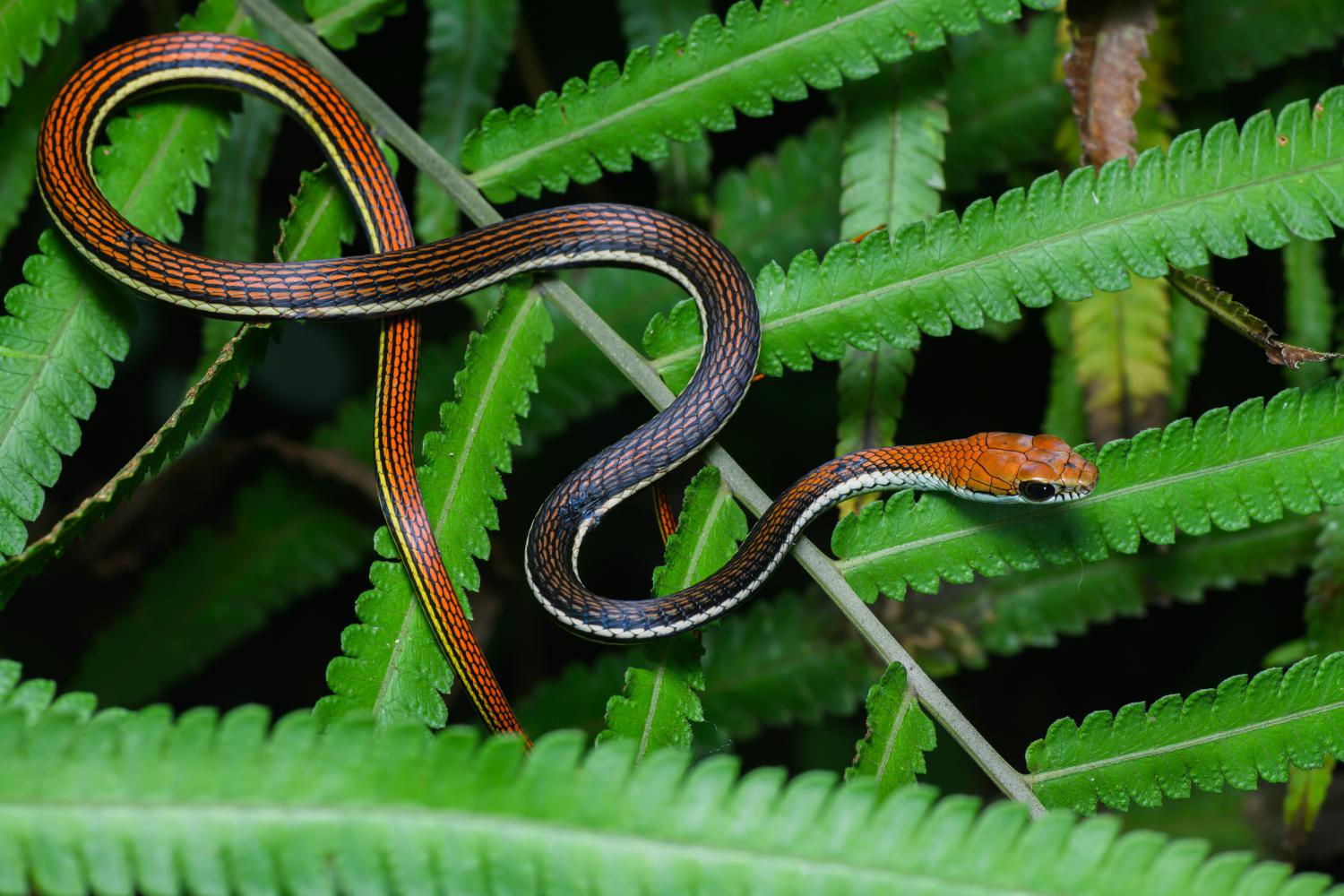
The striped bronzeback snake, also known as the Dendrelaphis caudolineatus, is a fascinating creature that captures the curiosity of both snake enthusiasts and casual observers. With its vibrant colors and sleek body, this non-venomous snake stands out among its reptilian counterparts. Found primarily in Southeast Asia, the striped bronzeback resides in various habitats, from dense forests to urban areas. Its distinctive stripes and slender shape make it an expert climber and arboreal hunter, preying on birds, lizards, and even small mammals.
In this article, we will delve into the enigmatic world of the striped bronzeback snake and uncover 19 intriguing facts about this captivating creature. From its physical characteristics to its behavior and unique adaptations, we will explore the wonders of the striped bronzeback and gain a deeper understanding of this remarkable reptile.
Key Takeaways:
- Striped Bronzebacks are non-venomous, agile climbers, and important for the ecosystem. Their unique striped pattern helps them blend in, making them elusive and fascinating creatures in Southeast Asia.
- These enigmatic snakes have glossy scales, excellent eyesight, and are diurnal, meaning they are active during the day. Their slender body shape and swift movement make them a captivating sight in the wild!
Striped Bronzeback is a species of snake.
Native to Southeast Asia, the Striped Bronzeback (Dendrelaphis caudolineatus) is a fascinating snake known for its distinctive striped pattern.
It belongs to the Colubridae family.
The Striped Bronzeback is a non-venomous snake and is classified under the family Colubridae, which includes more than two-thirds of all snake species.
It can grow up to 1.5 meters in length.
These snakes vary in size but can commonly reach lengths of up to 1.5 meters.
The striped pattern provides excellent camouflage.
Their unique coloration helps them blend seamlessly with their natural surroundings, making them difficult to spot.
They are proficient climbers.
Striped Bronzebacks are arboreal snakes, meaning they spend a significant amount of time in trees and are highly skilled climbers.
Their diet mainly consists of small vertebrates.
These snakes primarily feed on lizards, frogs, and small birds, using their quick reflexes to catch their prey.
They are generally non-aggressive towards humans.
Striped Bronzebacks are shy creatures and will usually avoid human interactions whenever possible.
They are oviparous.
Females lay eggs that hatch after an incubation period, and the young snakes emerge fully formed.
They have a rapid and agile movement.
Striped Bronzebacks are swift and agile, allowing them to move swiftly through the trees and vegetation of their habitat.
Their natural habitat includes forests and grasslands.
These snakes are commonly found in forested areas, as well as grasslands with dense vegetation, providing them with ample hiding spots.
Their population is considered stable.
Despite habitat loss due to deforestation, the population of the Striped Bronzeback is currently not facing any significant threats.
They have excellent eyesight.
Their well-developed eyesight allows them to detect movement, locate prey, and navigate through their environment.
Their skin has a glossy appearance.
The scales of the Striped Bronzeback give it a shiny and lustrous appearance, reflecting light in an eye-catching way.
They are diurnal creatures.
These snakes are active during the daytime, basking in the sun to regulate their body temperature.
They may exhibit territorial behavior.
Male Striped Bronzebacks may engage in territorial displays to defend their preferred areas from other males.
They are known for their slender body shape.
The Striped Bronzebacks have a long and slender body, allowing them to move swiftly through narrow spaces.
Their scales allow for flexibility.
The overlapping scales on their body enable them to bend and twist easily, aiding them in their arboreal lifestyle.
They are agile swimmers.
When necessary, these snakes can also venture into water and swim with ease.
They are important for ecosystem balance.
As predators, the Striped Bronzeback plays a vital role in maintaining the population of their prey species and overall ecosystem balance.
These were 19 enigmatic facts about the Striped Bronzeback, a fascinating snake species that inhabits the forests and grasslands of Southeast Asia. From their remarkable striped pattern to their exceptional climbing abilities, these snakes continue to intrigue scientists and nature enthusiasts alike. With their non-aggressive nature towards humans and their importance in maintaining ecosystem balance, the Striped Bronzeback holds a significant place in the natural world.
Whether it’s their glossy scales or their captivating movement through trees, encountering a Striped Bronzeback in the wild is truly a memorable experience. So, keep these interesting facts in mind and next time you find yourself in the Southeast Asian wilderness, keep an eye out for the elusive and enigmatic Striped Bronzeback!
Conclusion
The Striped Bronzeback is undeniably a captivating and enigmatic reptile. Its distinctive striped pattern and bronze-colored scales make it a remarkable sight in the animal kingdom. From its intriguing behavior to its adaptations, there are many fascinating facts to discover about this snake.One of the most intriguing aspects of the Striped Bronzeback is its ability to camouflage itself within its surroundings. Its coloration and markings help it blend seamlessly into the foliage, making it difficult for predators and prey alike to spot it.Additionally, the Striped Bronzeback has a unique hunting technique. Rather than using venom to immobilize its prey, it relies on constriction to capture and subdue its victims. This method sets it apart from many other snake species and adds to its mysterious allure.Overall, the Striped Bronzeback is a captivating creature that continues to surprise and intrigue researchers and nature enthusiasts alike. Its enigmatic nature and distinctive characteristics make it a truly remarkable addition to the diverse world of animals.
FAQs
Q: What is the average size of the Striped Bronzeback?
A: The average length of an adult Striped Bronzeback ranges from 70 to 100 centimeters.
Q: Are Striped Bronzebacks venomous?
A: No, Striped Bronzebacks are not venomous. They rely on constriction to capture their prey.
Q: What is the diet of the Striped Bronzeback?
A: The diet of the Striped Bronzeback primarily consists of small reptiles, amphibians, and occasionally small rodents.
Q: Where can the Striped Bronzeback be found?
A: The Striped Bronzeback is primarily found in Southeast Asia, including countries like Thailand, Malaysia, and Indonesia.
Q: Are Striped Bronzebacks endangered?
A: Currently, the Striped Bronzeback is not listed as an endangered species, but it is still important to protect their natural habitats to ensure their survival.
Striped Bronzeback snakes are just one of the many fascinating creatures in the animal kingdom. Dive deeper into the world of serpents with our article on snake facts, which explores the incredible diversity and adaptations of these misunderstood reptiles. Reptiles as a whole are equally captivating, with their unique characteristics and ecological roles – learn more in our piece on 13 best facts about these ancient creatures. Finally, broaden your horizons and discover the wonders of wildlife in our comprehensive article, which showcases the astonishing variety and importance of animals in ecosystems around the globe.
Was this page helpful?
Our commitment to delivering trustworthy and engaging content is at the heart of what we do. Each fact on our site is contributed by real users like you, bringing a wealth of diverse insights and information. To ensure the highest standards of accuracy and reliability, our dedicated editors meticulously review each submission. This process guarantees that the facts we share are not only fascinating but also credible. Trust in our commitment to quality and authenticity as you explore and learn with us.


